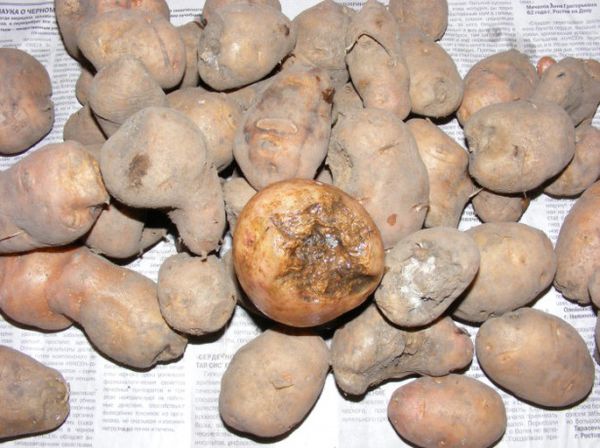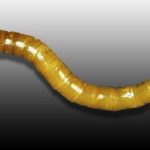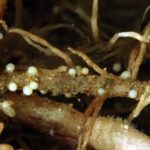Despite the fact that the potato - an unpretentious plant, it is among the most affected by diseases and pests of crops. All summer residents know about the Colorado potato beetle, which is visible to the naked eye. However, large losses of potato harvest can be caused by a microscopic pest - a potato nematode. This is a round worm, the size of which does not exceed 1 mm.
All potato nematodes are highly fertile and exist by feeding on the host plant. In Russia, there are several species of this pest.
Table of contents
Types of potato nematode in Russia
Golden and pale
These two species are potato cyst nematodes and cause disease. globoderosis. Malicious pests, they are in the Russian Federation objects of internal and external quarantine.
- Golden nematode larva
- Pale nematode cysts
The pest lives in the ground, spreads through the soil, containers and tools, tubers with remnants of the earth, melt water, etc. Saved in the soil up to 10 years.
The golden potato nematode is found throughout the world, including in Russia, especially in its central part and Siberia. The pale nematode is common in Europe, Latin America, Canada, cases of occurrence in Russia are not registered.
The life cycle of both types of parasite is the same and continues about 40-60 days. Pest winters in the form of larvae and eggs in durable cysts.
In the spring, when new potatoes sprout, larvae develop from eggs and penetrate into the roots of the plant. The maximum distance of their movement in the soil is 1 meter.In the roots, they lose mobility and develop until they become males and females. The optimum temperature for life is 15-20 degrees.
Males enter the soil completely, and females gradually grow, thicken and tear up the roots, remaining partially inside the plant. After fertilization, males die, and females begin to lay eggs inside their own bodies. The fecundity of one individual - from 200 to 1000.
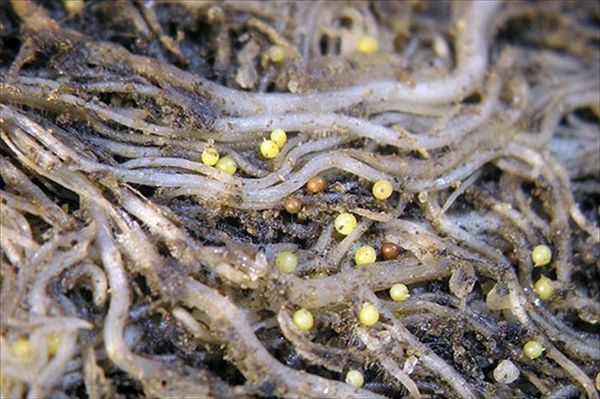
When the eggs mature, the female's body dies off, its outer shell becomes hard and becomes brown. So a cyst appears - a dead female with eggs inside. When harvesting potatoes, cysts fall off, fall into the soil and hibernate there.
Golden nematode is called because during the life cycle her female changes color: at first it is white, then cream, and finally golden yellow. In females of the pale nematode, the white-cream color remains dominant.
Stem Potato Nematode
The female can lay eggs at a temperature from 5 to 37 degrees. The life cycle takes 20-45 days. Pests overwinter in the egg stage, well tolerating the freezing of the soil.
Especially great harm is caused to early varieties.Infection occurs more often from the uterine tuber than through the soil. From the ground the nematode penetrates the tuber while it forms. Particularly severe pest damage in rainy years.
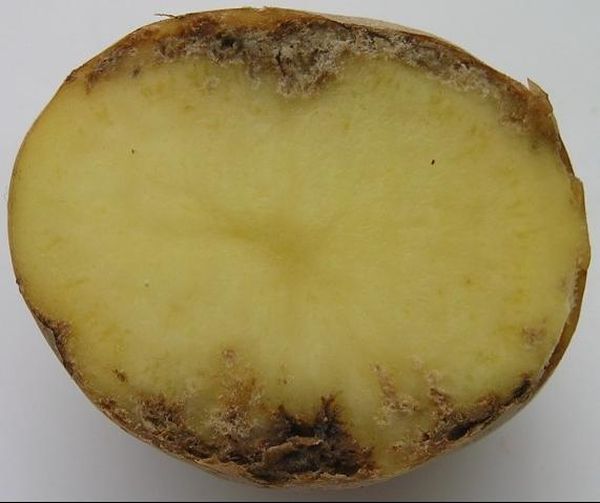
Northern Gallic
The pest parasitizes on different plants, including potatoes, in which causes tuberous tuberculosis. Growths (galls) appear on the roots of an infected plant, as a result of which the internal conducting vessels become blocked and the plant begins to experience a lack of nutrients. In cold winters it dies in the soil.
There is a danger that in the coming years other species of gall nematode may appear in Russia - the Colombian (Meloidogyne chitwoodi) and the nematode Meloidogyne fallax. These pests are already found in Europe.
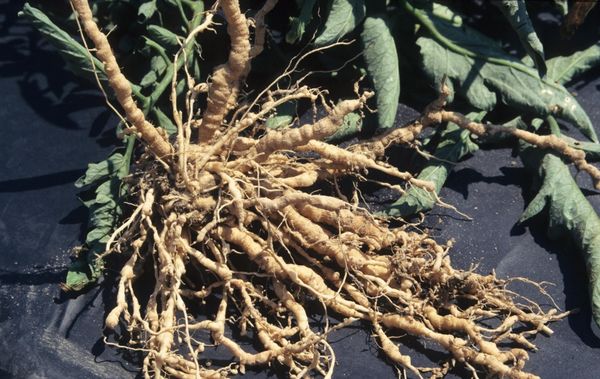
Signs of defeat
Symptoms of golden infection
Defeat always begins as focal.
Signs:
- young plants are stunted;
- stems are frail, leaves are small;
- is observed premature yellowing of foliage down up;
- razmozaleny roots, with a strong defeat, additional roots may be formed, as the plant suffers an acute shortage of food.
After 7 weeks after planting on the roots, you can see the pest cysts, first white, then bright yellow and eventually red-brown.
Tubers always small and few. Symptoms are especially pronounced if the potato grows on poor, low-fertilized soils.
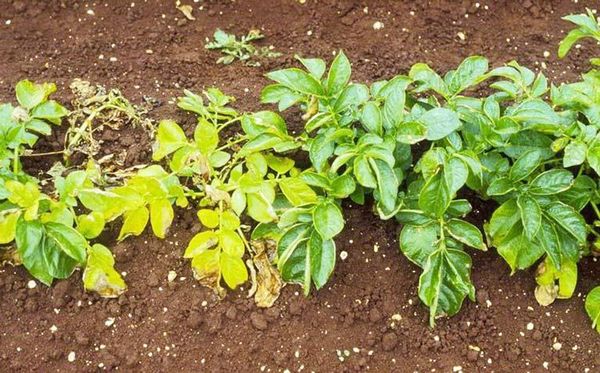
Symptoms of stem infection
Usually there are no external manifestations of the pest. In case of severe damage leaves turn pale, wavy along the edges. The internodes are shortened, the stems become thicker and more bushy.
On tubers under the peel appear small white spots with a hole in the center. The flesh gradually becomes soft in the affected area. During storage on the tubers are formed dark spots with a lead shade. Over time, they increase and crack, from which the tuber dries quickly.
Prevention and control measures
Agrotechnological
The main method of pest control is the use of nematode-resistant varieties and the avoidance of monoculture.
Since the parasite lives in the soil, the annual planting of potatoes in one place contributes to the rapid spread of the pest. To avoid this, potatoes should be alternated with growing other crops, i.e. 4-5 year crop rotation.
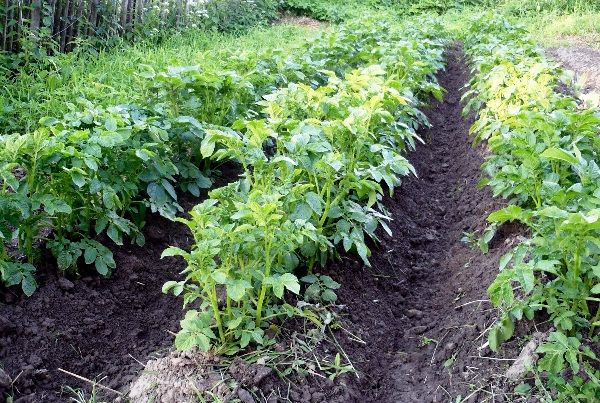
The best predecessors will be plants that are not affected by this pest:
- cereals (including corn);
- legumes;
- legume-cereal mixtures;
- siderata (lupine, mustard, canola);
- pure steam.
The essence of the method: in the fall, after harvesting and thoroughly cleaning the field from plant residues, the plot is brought in manure (160-240 t / ha), dug up and snatched with a thick layer of mulch. For example, you can use chopped straw, hay, or mowed grass. With a layer of mulch, the field is left for the winter.
In early summer, all sprouting potatoes that were missed during autumn harvesting are removed from the site. Shelter is not removed. In the dry period water the field 1-2 times. After another wintering, the remnants of the mulch layer are removed, a potato variety resistant to the nematode is planted on the field, and grown for at least two years in a row.
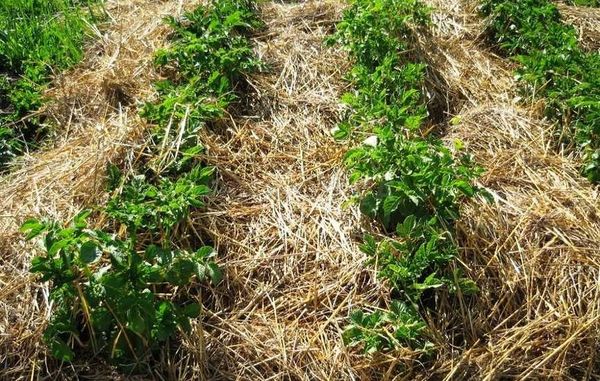
Efficiency of the method: under favorable weather conditions (warm winter, a lot of precipitation in summer), the abatement of the pest can reach 98%. Nematode larvae will die from natural enemies: bacteria, ticks, predatory fungi.
You can not always plant only nematode-resistant varieties of potatoes. This may cause the pest to become more resilient. Every 3-4 years they plant an ordinary variety.
Chemical
Potent chemicals can be ineffective, as cysts in the soil are protected by a hard shell, and after the larvae are introduced into the plant, the use of pesticides can harm future crops.
Some chemical ways of combating:
- A month before planting in those places where infected plants grew last year, they bring urea and watered with the infusion of potato sprouts: the larvae awaken, enter the soil and die.
- When planting potatoes in the well contribute ash, bird droppings powder, rotted manure. All this is sprinkled with earth and planted tuber.
- After planting the soil is watered. liquid chicken manurediluted with water 1:20. Irrigation rate 4-10 liters per 1m2. Such a solution is detrimental for pest larvae.
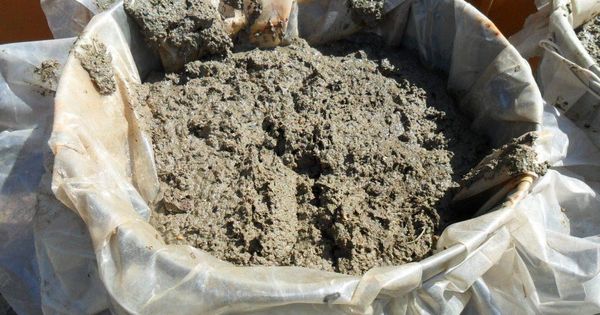
Folk ways
To popular methods to fight the pest include the following tricks:
- Manure soil fertilizer. In fertile soil, microorganisms are well developed - the natural enemies of the pest.
- Sowing rye after harvesting potatoes. According to the observations of gardeners, rye is better than other cereals, helps reduce the number of nematodes in the area.
- Use of plant defenders. Experienced gardeners plant small marigolds, calendula and rudbeckia next to potatoes, whose smell and root excretions do not like parasites.
Such plants need remove from the site and burn. After working with an infected plant, rinse well and better disinfect containers, tools, and shoes that come into contact with the ground.
In general, proper observance of crop rotation, attentive care for potatoes, timely application of fertilizer to the soil help prevent the spread of the parasite on the site. After all, the best way to combat any plant diseases is prevention.
